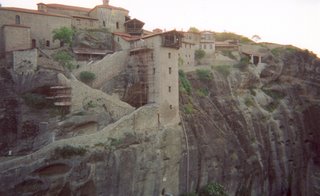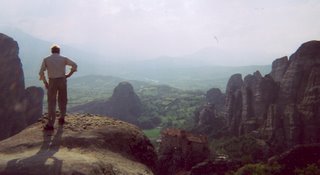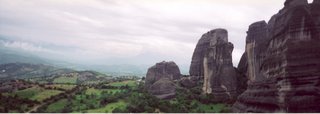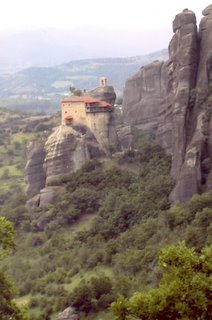Third parties may place cookies on this site. That is beyond our control. Please be advised.
Greece Road Ways Two on the Loose. This two: C&J.
Two people, heading out, an improvised road trip with safeguards, hospitality extended, and contacts (thanks so much), this time Jon and Carol. Athens, Aegina (island), Thermopylae, Meteora (shown), Metsovo, Ionnina, Thessaloniki, Kavala, Drama, American Farm School, Olympos, Corinth, Mycenae, Nafplio. Trips hub: see europeroadways.com.
Thursday, December 13, 2018
Friday, November 18, 2011
Vergina, Macedonia, between Mt. Olympus and Thessoloniki
Macedonia is a region of Greece. Macedonia with the same name also references a different area, a country known as the Former Yugoslav Republic of Macedonia, and that had been part of the old Yugoslavia, and joined the United Nations as an independent nation with this name. Greece claims the single name "Macedonia" for its section; nationalism, history, identity, all collide, see http://www.historyofmacedonia.org/MacedonianGreekConflict/shea.html;
and then, http://www.unitedmacedonians.org/macedonia/stefov1.html
- Macedonia. The total area was Macedon, and a great king, Philip II, born 382 BC, ruled 360-336 BC, made it great in the ancient world, see http://www.livius.org/phi-php/philip/philip_ii.htm (that site extends into four sections).
- Philip was the father of Alexander the Great, Philip's Grave is believed to be at the Great Tumulus in Vergina, but little remains of its grandeur. See Archeology Odyssey magazine, March-April 2005 at p. 32ff, article by Greek archeologist Manolis Andronicos. The access to the tumulus is through a climate-controlled structure extending underground
Monday, December 14, 2009
Aegina Island - Octopus; pistachios
Aegina is is one of the Saronic Gulf islands, a Greek island not far from Piraeus, the port of Athens, and is a splendid day trip. On the way, going with friends and not on a tour, I looked over from the prow and saw a sea turtle below. Not huge, but vigorous. See http://www.greektravel.com/greekislands/aegina/
1, Old habitations are being refurbished, rebuilt, expanded. This: a work in progress.
 Fisherman's cottage, Aegina Island, Greece
Fisherman's cottage, Aegina Island, Greece
2, Octopus - hanging in the fish shops. Grill it. Goes in salads, or by itself. Just a little olive oil and garlic. To tenderize, the catch used to be pounded on rocks.
How to tenderize your octopus? It is possible to use old washing machines to beat-paddle the (dead) octopus for tenderizing. Recipe and lore for : for grilled octopus, go to http://www.departures.com/articles/octopus
3. Driving snacks. Aegina pistachios -- a variety among the best in the world. See http://www.nutsonthenet.com/page.html?chapter=1&id=27
1, Old habitations are being refurbished, rebuilt, expanded. This: a work in progress.
 Fisherman's cottage, Aegina Island, Greece
Fisherman's cottage, Aegina Island, Greece2, Octopus - hanging in the fish shops. Grill it. Goes in salads, or by itself. Just a little olive oil and garlic. To tenderize, the catch used to be pounded on rocks.
How to tenderize your octopus? It is possible to use old washing machines to beat-paddle the (dead) octopus for tenderizing. Recipe and lore for : for grilled octopus, go to http://www.departures.com/articles/octopus
3. Driving snacks. Aegina pistachios -- a variety among the best in the world. See http://www.nutsonthenet.com/page.html?chapter=1&id=27
Sunday, December 13, 2009
Aegina - Britomartis Finds Safety on the Island, Huntress. Name Migrations?
Aegina is a small island about an hour by water away from Piraeus, the closest port to Athens.
We enjoyed a day there, and now look at its roots.
Topic: The roots of our names, and the course that those names follow from culture to culture. Here, Aegina the island features in the story of Bradamante, the female knight from the middle ages.
A. Tracing Bradamante, Female Knight.
1. The Italian tradition.
There is a tradition of female knights in the Italian "Renaissance Guerriera" tradition. In that tradition, the autonomous female knight is possessed of beauty and great strength (some in later years added the pejorative to take away some of the glamor, and portrayed here as a virago). Part of the tradition is Bradamante as a loner. She may or may not eventually settle down with her lover. See Italy Road Ways, Order of the Glorious Saint Mary.
Name derivation. Bradamante had been translated as a name, to suggest an untamed one, especially in love. See ://babynamesworld.parentsconnect.com/meaning_of_Bradamante.html/. Wild lover.
Finding Britomartis.
2. The earlier Minoan Tradition.
However, the Bradamante name also was suggested as rooted in the ancient Minoan myths of Britomartis, huntress of small game, says this site. The king, Minos of Crete, wanted her and chased.
She fled, leaped into the sea where she became entangled in fishing nets, and the fishermen carried her to safety to the Island of Aegina. See ://www.theoi.com/Georgikos/Britomartis.html/
3. Stag slayer; archer
Other versions of the story at that same site have Britomartis as slayer of stags. And a goodly archer. That story comes to us from the 1st century BC. As time passed, it, too, was watered down such that she became a mere hunter of small game, chipmunks?
Enjoy the description of the stag slayers, other nymphs of the hunt. Perhaps as Britomartis morphed into Diana:
4. A Wild One.
Reducing her stature and power went on and on. She was reduced later to a mere "wild lover"
5. A Recluse.
But yet another story cited there has Britomartis avoiding the company of men. She does escape their ravaging intentions over and over.
B. Britomartis:
Britomartis, Did she morph into Bradamante. Did the two lines of stories blend.
Britomartis as a name comes from words meaning sweet or blessing, or sweet or blessed maiden. See later blends of characteristics with Artemis, or Diana. It may have been Artemis who saved her (Artemis also loved her) and who made her into a goddess. This gets complex. See site.
Lovely Aegina, island with the grilled octopus to die for. Another reason to love it, wildly.
We enjoyed a day there, and now look at its roots.
Topic: The roots of our names, and the course that those names follow from culture to culture. Here, Aegina the island features in the story of Bradamante, the female knight from the middle ages.
A. Tracing Bradamante, Female Knight.
1. The Italian tradition.
There is a tradition of female knights in the Italian "Renaissance Guerriera" tradition. In that tradition, the autonomous female knight is possessed of beauty and great strength (some in later years added the pejorative to take away some of the glamor, and portrayed here as a virago). Part of the tradition is Bradamante as a loner. She may or may not eventually settle down with her lover. See Italy Road Ways, Order of the Glorious Saint Mary.
Name derivation. Bradamante had been translated as a name, to suggest an untamed one, especially in love. See ://babynamesworld.parentsconnect.com/meaning_of_Bradamante.html/. Wild lover.
Finding Britomartis.
2. The earlier Minoan Tradition.
However, the Bradamante name also was suggested as rooted in the ancient Minoan myths of Britomartis, huntress of small game, says this site. The king, Minos of Crete, wanted her and chased.
She fled, leaped into the sea where she became entangled in fishing nets, and the fishermen carried her to safety to the Island of Aegina. See ://www.theoi.com/Georgikos/Britomartis.html/
3. Stag slayer; archer
Other versions of the story at that same site have Britomartis as slayer of stags. And a goodly archer. That story comes to us from the 1st century BC. As time passed, it, too, was watered down such that she became a mere hunter of small game, chipmunks?
Enjoy the description of the stag slayers, other nymphs of the hunt. Perhaps as Britomartis morphed into Diana:
"These were the first who wore gallant bow and arrow-holding quivers on their shoulders; their right shoulders bore the quiver strap, and always the right breast showed bare."That also from ://www.theoi.com/Georgikos/Britomartis.html/
4. A Wild One.
Reducing her stature and power went on and on. She was reduced later to a mere "wild lover"
5. A Recluse.
But yet another story cited there has Britomartis avoiding the company of men. She does escape their ravaging intentions over and over.
B. Britomartis:
Britomartis, Did she morph into Bradamante. Did the two lines of stories blend.
Britomartis as a name comes from words meaning sweet or blessing, or sweet or blessed maiden. See later blends of characteristics with Artemis, or Diana. It may have been Artemis who saved her (Artemis also loved her) and who made her into a goddess. This gets complex. See site.
Lovely Aegina, island with the grilled octopus to die for. Another reason to love it, wildly.
Labels:
Aegina,
Bradamante,
Britomartis,
Crete,
Greece,
Greek island,
King Minos,
Krete,
Minoan myth
Wednesday, January 23, 2008
New Parthenon Museum
The Parthenon, 5th Century BC, and finally its own Museum at its feet, by Swiss architect Bernard Tschumi. Do an images search right now to appreciate it. Thank you, Greece. We have not seen it yet (parts of columns and other items were there on the grounds, but under shelters, so we have an idea where it is) but the descriptions put it among the great designs for museums, we think. See the article in the NYT 10/28/2007, article about p. 31 by Nicolai Ouroussoff: building was raised on columns to preserve an ancient village discovered below, "overscale concrete canopy" over the entrance, concrete and glass grid, corners of the top floor cantilever slightly, all creating an "instability" that serves the narrative as the goer goes through the exhibits. Yet, "calm and unobtrusive." Forms growing more precarious, says the article. "A montage of visual experience." The article directs us to slide show at nytimes.com/design.
Wish we had this for the old Iraq museum. We have little idea, and now it is too late, thanks to us.
Much of Greece's treasure of antiquities were taken to other countries in the last century, and even probably to now, with even half of the famous Elgin Marbles still at the British Museum in London - taken there by one Lord Elgin - still in London. Read about Lord Elgin at ://www.athensguide.com/elginmarbles/lordelgin.html; and the Elgin Marbles at ://www.athensguide.com/elginmarbles/index.html#menu. Mr. Ouroussoff went to London immediately after Athens, saw the Elgin Marbles there, and said they looked homesick.
Theft of heritage. See ://www.museum-security.org/artifacts-saz.htmWas Elgin the one who saved the marbles by taking them? See ://www.bbc.co.uk/history/ancient/greeks/parthenon_debate_01.shtml.
Iraq. See ://www.pbs.org/newshour/updates/middle_east/jan-june07/artifacts_04-30.html. The US not concerned or safeguarding another nation's heritage.
What is in our cultural narrative that so degrades the past. Even our own. Do we teach our real history. Read "Mayflower," by Nathaniel Philbrick, at ://www.nytimes.com/2006/06/04/books/review/04shorto.html?ex=1307073600&en=3ff4700633a5d05c&ei=5088&partner=rssnyt&emc=rss.
Human opportunism, here, in politics, there, and elsewhere. Mr.Ouroussoff writes that even he could see little reason at this late date to do any returning, but he changed his mind after entering the New Acropolis Museum.
A village was discovered during construction, and that is preserved because the structure is elevated above - excellent.
Wish we had this for the old Iraq museum. We have little idea, and now it is too late, thanks to us.
Much of Greece's treasure of antiquities were taken to other countries in the last century, and even probably to now, with even half of the famous Elgin Marbles still at the British Museum in London - taken there by one Lord Elgin - still in London. Read about Lord Elgin at ://www.athensguide.com/elginmarbles/lordelgin.html; and the Elgin Marbles at ://www.athensguide.com/elginmarbles/index.html#menu. Mr. Ouroussoff went to London immediately after Athens, saw the Elgin Marbles there, and said they looked homesick.
Theft of heritage. See ://www.museum-security.org/artifacts-saz.htmWas Elgin the one who saved the marbles by taking them? See ://www.bbc.co.uk/history/ancient/greeks/parthenon_debate_01.shtml.
Iraq. See ://www.pbs.org/newshour/updates/middle_east/jan-june07/artifacts_04-30.html. The US not concerned or safeguarding another nation's heritage.
What is in our cultural narrative that so degrades the past. Even our own. Do we teach our real history. Read "Mayflower," by Nathaniel Philbrick, at ://www.nytimes.com/2006/06/04/books/review/04shorto.html?ex=1307073600&en=3ff4700633a5d05c&ei=5088&partner=rssnyt&emc=rss.
Human opportunism, here, in politics, there, and elsewhere. Mr.Ouroussoff writes that even he could see little reason at this late date to do any returning, but he changed his mind after entering the New Acropolis Museum.
A village was discovered during construction, and that is preserved because the structure is elevated above - excellent.
Labels:
antiquity theft,
Athens,
Iraq,
Lord Elgin,
New Acropolis Museum,
Parthenon
Tuesday, September 18, 2007
Parthenon and its Outlying Neighborhoods - Life Uncropped
 Parthenon, Athens, Greece
Parthenon, Athens, GreeceI. Most photos that show the Parthenon will focus on its antiquity and leave out its environment, its present context. What is the Acropolis, the rock on which the Parthenon, Temple of Athena, patron goddess of Athens rises.
Update 2014: Explore the meaning of the Parthenon's frieze. Read The Parthenon Enigma, Joan Breton Connelly, review by Caroline Alexander in the NYT at http://www.nytimes.com/2014/01/26/books/review/the-parthenon-enigma-by-joan-breton-connelly.html?_r=0/
- Do the figures depict a religious procession, where a dedicated robe is offered to the goddess. But there are inconsistencies. Is it instead a depiction of a sacrifice of a child, not merely a child handing over a robe. Or is it not a continuous story at all, but separate subjects.
And what is the shortened story of Athena that comes to us? What more is to learn, see Parthenon, Athena, Athene Partheneia
II. The Surround
Look further to the rooftops below. There are real neighborhoods surrounding. The markets. The Plaka. Who is there? Archeology can tell us that there was indeed crowding and disease in Athens then, as we have now, see http://www.archaeology.org/online/news/kerameikos. Enjoy the Parthenon in a fuller setting here: the warren of the market, the housing, rooftops, awnings against the sun, real people living nearby.
Should we have cropped out the neighborhoods, to focus on the Parthenon? Crop the picture, crop the narrative, exclude important evidence, reduce how people think, create and send a new agenda. All becomes marketing.
III. Ambiguity of the Frieze. The Elusive Past; the persistent sales job for agenda du jour
Are the ancient Greek battles like Serbia's battle of Kosovo Plain, 1389. Do interpretation and drive for an ideology create new facts where before they were not clear at all. Who really won at Kosovo Plain? Who did the epics say won, and why? Later interpretation and need for myth, filling in where the facts are not at all clear. See Europe Road Ways Themes, Kosovo I and Kosovo II.
It is the tellers of tales who dominate any time facts are concealed or cannot be accessed. Politics?
Thursday, August 30, 2007
Nafplio or Nafplion - Peloponnese, Venetians
 Nafplio, Peloponnese, Greece
Nafplio, Peloponnese, GreeceUpdate August 2007 - with the fires in the news, but I think mostly inland.
Nafplion is on the Peloponnese Peninsula, coast, southeast of Athens and the mainland. This is a beautiful resort destination. Imagine great romance. Not difficult in this setting. It was occupied by the Venetians, look up the place names associated with the old Venetian empire at //romeartlover.tripod.com/Salmglos., then to the History of Venice, then down to Napili di Romania, Port of Morea on the Gulf of Argos (Argos was the ancient town there), and see that its current name is Nafplion.
Click on the links there for the port and the fortress --there is a 15th century fort at the top of the hill. See //romeartlover.tripod.com/Argo; and //romeartlover.tripod.com/Nauplia.
The modern town: elegant Greek-Venetian architecture. Splendid for a cruise stop. See www.greecetravel.com/nafplio/ For other history and photos, see www.delboy85.tripod.com/ppenese/id6.
On the way: artichoke fields. In bloom. Read the historian Herodotus on the ancient world 450BC. or so, for an idea of the vibrancy and movement among peoples. Artichokes at that time in Mauritania, says Strabo - huge. //www.fordham.edu/Halsall/ancient/anc-nafrica.
Wednesday, August 29, 2007
Meteora - clifftop monasteries
The geology of Meteora: It had been, in remote times, undersea, rivers then carving around prominences as water fell, land exposed. See http://www.meteora-greece.com/
 Meteora, Monastery, Greece
Meteora, Monastery, Greece
Monasteries were constructed on cliff-tops, many on free-standing geological formations like air islands. If At the center here, see see the ropes hanging down that suspended the baskets that were the only way up for people and goods in the old days. There also was a suspended rope between the monastery and the cliff on the other side, for a way over. See http://www.in2greece.com/english/places/historical/mainland/acropolis.
Geo-tourism: This site would be excellent. See book "Geotourism" by Ross Dowling at this site: http://www.elsevier.com/wps/find/bookdescription.cws_home/706060/description#description.
 Meteora view, Monasteries, Greece
Meteora view, Monasteries, Greece
These monasteries were built around 1100 AD and thereafter, by hermits and monastics fleeing from the invading Ottomans, or for their own reasons - preferring isolation. See history of Meteora, http://www.greeka.com/thessaly/meteora/meteora-history.htm
There is an entire area of these stacks with or without structures on top. See www.orthodox-monasteries.com/greece/index5. See also www.in2greece.com/english/places/historical/mainland/meteora.
 Meteora, Creece. Conglomerate rock formations, and medieval monasteries
Meteora, Creece. Conglomerate rock formations, and medieval monasteries
One story of how these were built:
 Rock formations, monastery at summit, Meteora, Greece
Rock formations, monastery at summit, Meteora, Greece
These are World Heritage Sites. The area is on the list for many tour groups. See www.great-adventures.com/destinations/greece/meteora.
Wardrobe for Orthodox areas:
This is an orthodox area. Ladies, wear a skirt (I had a denim one, mid-calf, for easier climbing). Some women had a light shawl wrap, square-ish, that could be wrapped like a sarong to cover trousers.
 Clifftop monastery, Meteora, Greece
Clifftop monastery, Meteora, Greece
 Meteora, Monastery, Greece
Meteora, Monastery, GreeceMonasteries were constructed on cliff-tops, many on free-standing geological formations like air islands. If At the center here, see see the ropes hanging down that suspended the baskets that were the only way up for people and goods in the old days. There also was a suspended rope between the monastery and the cliff on the other side, for a way over. See http://www.in2greece.com/english/places/historical/mainland/acropolis.
Geo-tourism: This site would be excellent. See book "Geotourism" by Ross Dowling at this site: http://www.elsevier.com/wps/find/bookdescription.cws_home/706060/description#description.
 Meteora view, Monasteries, Greece
Meteora view, Monasteries, GreeceThese monasteries were built around 1100 AD and thereafter, by hermits and monastics fleeing from the invading Ottomans, or for their own reasons - preferring isolation. See history of Meteora, http://www.greeka.com/thessaly/meteora/meteora-history.htm
There is an entire area of these stacks with or without structures on top. See www.orthodox-monasteries.com/greece/index5. See also www.in2greece.com/english/places/historical/mainland/meteora.
 Meteora, Creece. Conglomerate rock formations, and medieval monasteries
Meteora, Creece. Conglomerate rock formations, and medieval monasteries One story of how these were built:
- A hermit made his way to the top of one summit, and wondered how to proceed with shelter. An eagle came by and dropped him a feather. Then, it dropped a piece of twig, and then enough materials to fashion a rope.
 Rock formations, monastery at summit, Meteora, Greece
Rock formations, monastery at summit, Meteora, GreeceThese are World Heritage Sites. The area is on the list for many tour groups. See www.great-adventures.com/destinations/greece/meteora.
Wardrobe for Orthodox areas:
This is an orthodox area. Ladies, wear a skirt (I had a denim one, mid-calf, for easier climbing). Some women had a light shawl wrap, square-ish, that could be wrapped like a sarong to cover trousers.
- . If you are dressed inappropriately, including either long pants or shorts, the monastery will loan you a shawl from a large stack in the corner. Ladies in shorts or pants not allowed.
- Cover your shoulders. Carry around your own silky covering or buy one of the sarong squares. This is more convenient than raincoats, and serves for picnics and tidier car snacking.
 Clifftop monastery, Meteora, Greece
Clifftop monastery, Meteora, Greece
Labels:
geo-tourism,
geotourism,
hermits,
Meteora,
monasteries,
Ottomans,
photos,
wardrobe for Orthodox areas
Tuesday, August 28, 2007
Fires on the Peloponnese.
 Olympus, view. Greece
Olympus, view. GreeceWhere are the gods when we need them?
Travel makes news personal. In August 2007, there were vast fires on the Peloponnese peninsula. For an idea of the scope, see the New York Times slide show today at //www.nytimes.com/slideshow/2007/08/28/world/20070828GREECE_index.html?th&emc.
If you are inclined to contribute, idea: Find a trusted local conduit and learn something of the people in your area from there. Visit Greek Orthodox churches for leads, or local schools that may have Greek exchange students, or find a trusted American project and follow through to check it out - example, try The American Farm School in Thessaloniki, Greece. Go to www.afs.edu.gr/. An advantage here is the English-speaking.
There is never assurance that all you contribute will get to the place or people needed. Leave it to the gods. Letting things go is good for your health.
Monday, June 18, 2007
Ioannina and Metsovo area - Orthodox, Vlach and Turkish roots, and hilltop village area
 Ionnanina, monastery, Greece
Ionnanina, monastery, GreeceThis area is north and west, from the Athens area, toward Albania. To the left here is an Orthodox monastery: one of many.
There are numerous hilltop towns.
 Metsovo, village, Greece
Metsovo, village, GreeceMetsovo is a large town, with a substantial Vlach and Turkish influence.
Vlachs originated as a shepherding, nomadic culture. See www.vlachophiles.net/liddell. We found Vlachs in Romania, see Romania Road Ways;.
The picture here is a small mountain town heading from Metsovo to Ioannina. Roadsign: See a fine photo album at www.galenfrysinger.com/metsovo_greece. The area is highly traditional, old Turkish influence also there.
Then, at Ioannina, is the administrative capital of the region, there are palace-castle ruins, and Turkish homes now open as museums. There is a lovely mosque. See www.arafura.net.au/greeksnt/ioannina; and www.metsovo.gr/.
Subscribe to:
Comments (Atom)